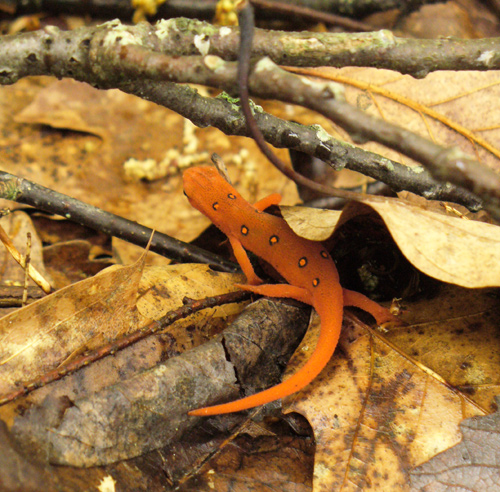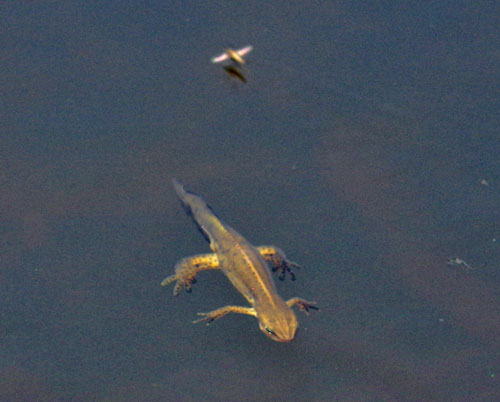Newts have rougher skin than members of other salamander families. The eastern newt, or red-spotted newt, is the only newt in Connecticut. Adult eastern newts are olive green with small red spots. Their bellies are yellow with small black speckles. They can be up to 4 inches long.
Eastern newts range through the eastern half of the US. They have no protected status in Connecticut.
Adults are aquatic. They live in many types of waterbodies and prefer permanent ponds and lakes. They are often found in beaver ponds. Adults can swim about under the ice and are active all winter.
Breeding season is late winter to spring. Males and females engage in a courtship dance with the male holding his tail over his head and waving it. He may hold the female's head with his hind legs and nuzzle her with his nose. The female lays 200-400 eggs individually on submerged vegetation, a few a day. Not all her fertilized eggs may be laid the same season, this is uncertain. She does not guard her eggs. After 3 to 5 weeks the eggs hatch.
The eggs hatch into the aquatic larval stage. They mostly stay on the pond bottom camouflaged by mud. After a few months and usually in late summer, the larvae metamorphisize, develop lungs and become red efts.
Red efts are terrestial. They are bright orange with warty skin and black-bordered orange spots. This bright coloration is a warning, the red efts secrete toxic substances from their skin that makes them unpalatable. They are active day or night. The efts can travel over land to colonize new bodies of water. They may be about more often in the early morning or just after summer rain. Red efts hibernate for the winter under logs or leaf litter.
The eastern newt may remain in the red eft stage for 1 to 3 years after which they metamorphisize into the aquatic air-breathing adult form for the rest of their lifespan. They can live 5 to 15 years. The green adults also secrete toxic substances from their skin, but the red efts are more toxic than the aquatic adults.
All 3 stages of the eastern newt are carnivorous. They all eat invertebrates. The adults will also eat small tadpoles and fish.
...............................................................................................................................................................................................................................

